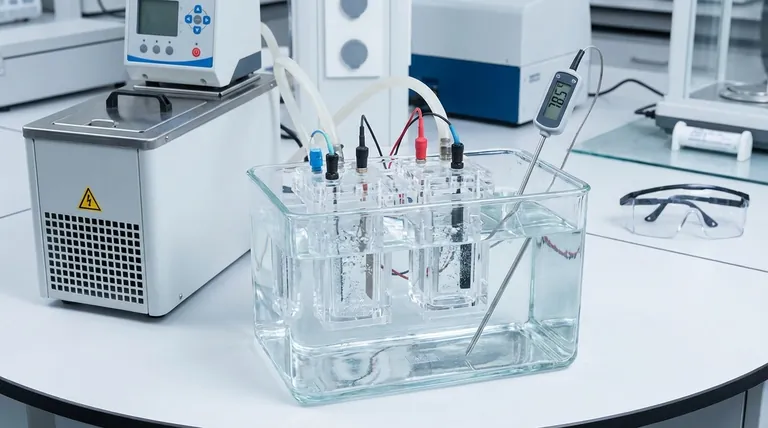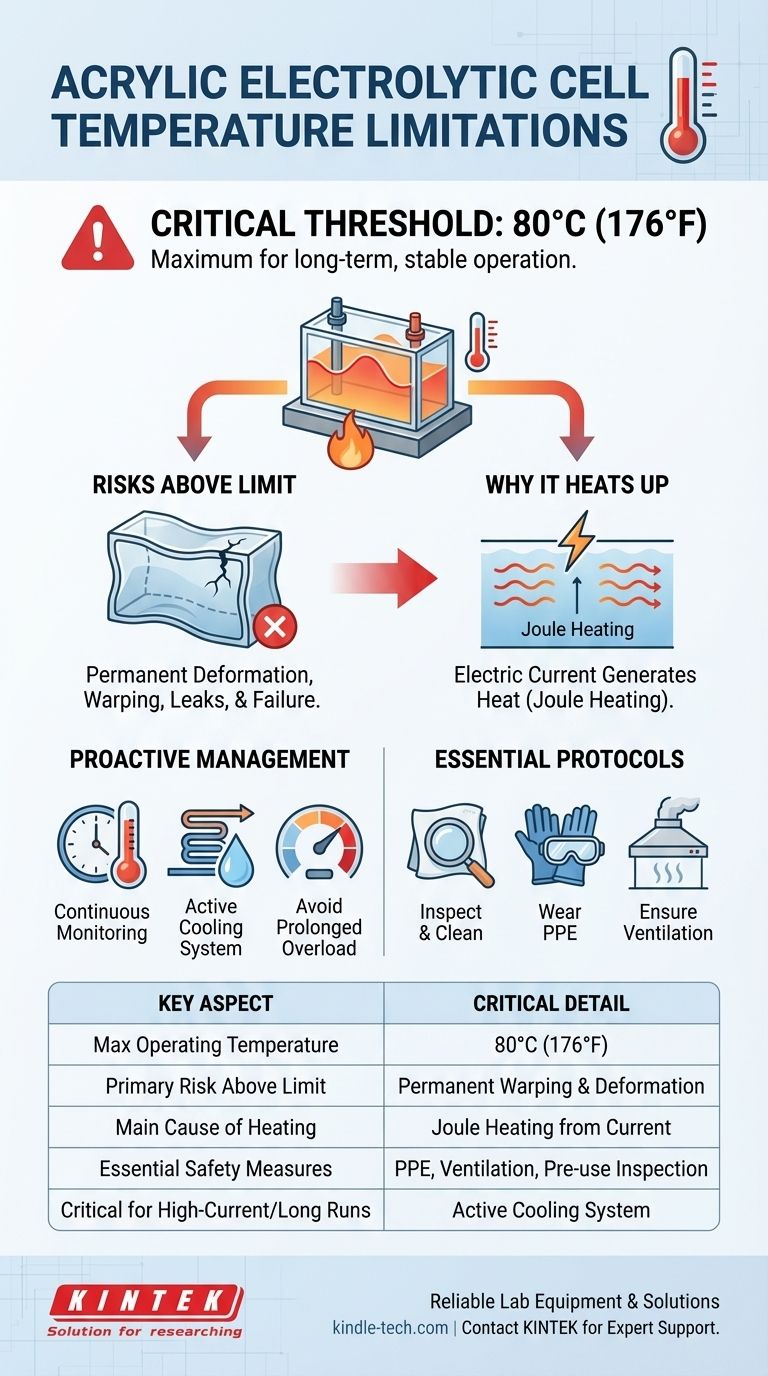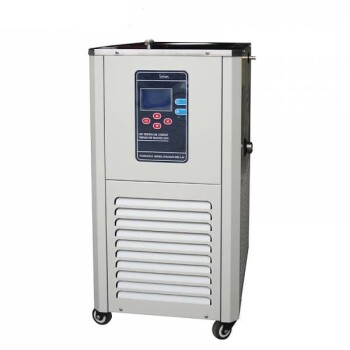To put it directly, the recommended long-term operating temperature for an acrylic electrolytic cell is at or below 80°C (176°F). If the electrolyte temperature exceeds this limit during your process, you must actively cool the cell to prevent the acrylic material from permanently deforming.
The core issue is that while acrylic is a versatile material for electrolytic cells, its moderate heat resistance is a critical operational boundary. Exceeding 80°C doesn't just risk a failed experiment; it risks destroying the cell itself.

Understanding the Thermal Limits of Acrylic
The entire structure and integrity of your cell depend on keeping the material within its specified thermal range. Ignoring this can lead to immediate and irreversible failure.
The 80°C Threshold
The manufacturer's guideline of 80°C is the maximum for long-term, stable operation. While an ideal operating temperature is closer to room temperature, 80°C serves as the absolute ceiling you should design your process around.
The Primary Risk: Deformation
When acrylic gets too hot, it softens. This will cause the cell to warp, deform, or lose its shape. This damage compromises seals, alters electrode spacing, and can easily lead to leaks, rendering the cell useless.
Why Temperature Rises During Electrolysis
The flow of electric current through the electrolyte naturally generates heat, a phenomenon known as Joule heating. High currents or prolonged operational periods will inevitably raise the temperature of the system.
Proactive Temperature Management
Effective temperature control is not a reactive measure but a fundamental part of a well-designed experimental protocol.
Continuous Monitoring is Essential
Your experimental records must include temperature readings taken at regular intervals. This data provides the only reliable way to know if you are approaching the cell's thermal limit.
Implementing a Cooling System
If your process generates significant heat, a cooling device is mandatory. This can range from a simple cooling water bath that the cell sits in, to more integrated cooling coils running a coolant through the electrolyte.
Avoid Prolonged Overload
Running the cell at currents or voltages significantly above its intended specifications is a primary cause of rapid overheating. Adhering to the recommended operational parameters is crucial for thermal stability.
Essential Operating and Safety Protocols
Beyond temperature, proper handling is critical for ensuring both safety and the longevity of your equipment. These steps should be considered standard procedure.
Pre-Experiment Inspection and Cleaning
Before every use, visually inspect the cell body for any cracks, damage, or potential leaks. Clean it thoroughly with a suitable solvent to remove grease, then rinse with distilled water and allow it to air dry completely.
Proper Filling and Electrolyte Handling
Slowly pour the electrolyte into the cell, ensuring you do not exceed 80% of its total volume. This simple step prevents splashing and provides a safety margin.
Personal Protective Equipment (PPE)
Always wear acid and alkali-resistant gloves and safety goggles. Electrolytes are often corrosive, and direct contact can be hazardous.
Ventilation is Non-Negotiable
Acrylic cells are typically non-sealed. Since electrolysis can produce harmful gases like chlorine, you must operate the cell in a well-ventilated area or under a fume hood to prevent the buildup of hazardous fumes.
Making the Right Choice for Your Process
Your approach to thermal management should directly reflect the intensity of your work.
- If your primary focus is on low-current or short-duration experiments: Regular temperature monitoring may be sufficient, but be prepared to intervene if temperatures rise unexpectedly.
- If you are running high-current or long-duration processes: An active cooling system is not optional; it must be an integrated part of your setup from the very beginning.
- If your priority is safety and repeatability: The complete checklist of inspection, cleaning, PPE, and proper ventilation is the only way to ensure reliable and safe outcomes.
By respecting its thermal limitations and adhering to rigorous operating protocols, your acrylic electrolytic cell will remain a dependable and safe tool.
Summary Table:
| Key Aspect | Critical Detail |
|---|---|
| Max Operating Temperature | 80°C (176°F) for long-term use |
| Primary Risk Above Limit | Permanent warping and deformation of the acrylic cell body |
| Main Cause of Heating | Joule heating from electric current in the electrolyte |
| Essential Safety Measures | PPE (gloves, goggles), fume hood ventilation, pre-use inspection |
| Critical for High-Current/Long Runs | Active cooling system (e.g., water bath, cooling coils) |
Ensure Your Experiments Run Safely and Efficiently
Managing thermal limits is critical for the success and safety of your electrolysis work. At KINTEK, we specialize in providing reliable lab equipment and consumables, including solutions for temperature control and electrochemical processes.
Why choose KINTEK for your laboratory needs?
- Expert Support: Get guidance on selecting the right equipment and setting up effective cooling systems for your specific application.
- Quality Assurance: Trust in durable, precision-engineered products designed for repeatable results.
- Comprehensive Solutions: From basic cells to advanced integrated systems, we have the tools to support your research.
Don't risk your experiments or equipment. Let our experts help you build a safe and effective setup.
Contact KINTEK today for a consultation and ensure your lab operates at peak performance and safety.
Visual Guide

Related Products
- H-Type Double-Layer Optical Electrolytic Electrochemical Cell with Water Bath
- Multifunctional Electrolytic Electrochemical Cell Water Bath Single Layer Double Layer
- Double-Layer Water Bath Electrolytic Electrochemical Cell
- Optical Water Bath Electrolytic Electrochemical Cell
- Quartz Electrolytic Electrochemical Cell for Electrochemical Experiments
People Also Ask
- What are the key features of a double-layer water-bath electrolytic cell? Achieve Precise Temperature Control for Your Experiments
- What is a H type cell? A Guide to Divided Electrochemical Cells for Accurate Experiments
- What is the overall structure of the H-type double-layer optical water bath electrolytic cell? Precision Design for Controlled Experiments
- What is the purpose of the double-layer design in the electrolytic cell? Achieve Precise Temperature Control for Your Reactions
- What is the structure of an H-type exchangeable membrane electrolytic cell? A Guide to Precise Electrochemical Separation



















